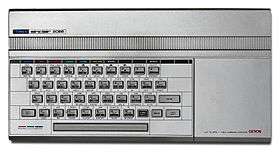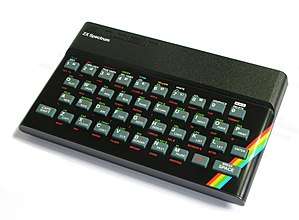Timex Sinclair 2068
The Timex Sinclair 2068 (TS2068), released in November 1983, was Timex Sinclair's fourth and last home computer for the United States market. It was also marketed in Canada, Argentina, Portugal and Poland, as the Timex Computer 2068.
 | |
| Type | Home computer |
|---|---|
| Release date | November 1983 |
| Discontinued | 1989 |
| Operating system | Sinclair BASIC |
| CPU | Zilog Z80A @ 3.5 MHz |
| Memory | 48 KB |
| Predecessor | Timex Sinclair 2048 |
| Successor | Timex Computer 3256 |
.jpg)
A variant of the machine was later sold in Poland under the name Unipolbrit Komputer 2086.[1]
Technical specifications
The TS2068 was based on the ZX Spectrum and followed Timex's ZX81-based TS1000 and TS1500, and the Spectrum-based TC2048.
Advertisements described the TS2068 as offering 72K of memory, color, and sound for a price under $200.[2] Like the TS2048 was announced as a 40K memory machine (16K RAM + 24K ROM), so the 2068 was announced as a 72K machine (48K RAM + 24K ROM).
The TS2068 was a more sophisticated device, significantly changed from its UK ancestor. Arguably one of the first Sinclair clones to significantly improve on the original design, it added a number of new features:
- an AY-3-8912 sound chip, as later used by Sinclair in the ZX Spectrum+ 128K (but mapped to different I/O ports and thus incompatible)
- twin joystick ports
- a slightly better "chiclet keyboard" with plastic keycaps
- a cartridge port to the right of the keyboard for ROM-based software[2]
- an improved ULA offering additional screen modes:
- The standard Sinclair 256×192 mode with a colour resolution of 32×24
- Dual screens (two 256×192 pixels, 32x24 colour resolution screens can be placed in memory)
- An "extended colour mode", 256×192 pixels with colour resolution of 32×192
- A monochrome 512×192 mode
Sinclair BASIC was extended with new keywords (STICK, SOUND, ON ERR, FREE, DELETE, RESET) to address the new hardware and the machine offered bank-switched memory, allowing ROM cartridges to be mapped in.
However, these changes made the machine incompatible with most Spectrum machine-code software, which is to say virtually all commercial titles; less than 10% would run successfully. In an attempt to remedy this, many TS users built a cartridge with a Spectrum ROM for emulation. The emulation was sufficiently accurate that it was able to run the majority of software produced for the Spectrum. Later, Timex of Portugal produced a Spectrum emulator cartridge that would auto-boot. This cartridge did not fit in a TS2068 as it was higher than TC2068 cartridges. The TC2068 casing was changed to accommodate this.
Although Timex Computer Corporation folded in February 1984, the independent Portuguese division continued to sell the machine in Portugal as the Timex Computer 2068, and Poland until 1989, as the Unipolbrit Komputer 2086. Although the Portuguese-made TC2068 was also sold in Poland, only the UK2086 was actually made there. Timex of Portugal sold 2 versions of TC2068: the Silver TC2068 version came with a ZX Spectrum emulator cartridge and a black TC2068 version sold with TimeWord word processing cartridge plus the Timex RS232 Interface to use TimeWord with a RS232 printer. Strangely the black version came with a silver keyboard template with TimeWord commands to be used with the program. It can be removed because it is not glued to the black keyboard template.[1]
Although the TS2068's main improvements over the original Spectrum were in areas that had come in for widespread criticism (graphics, sound, keyboard and—to a lesser extent—the lack of joystick ports and cartridge support), it was not used as the basis for the Spectrum's successors. The ZX Spectrum+ (1984) changed the keyboard only, and even the ZX Spectrum+ 128K (announced in May 1985, but not released in the UK until February 1986) retained the original machine's graphical capabilities. However, unlike the UK models, the TS2068 was not burdened by the requirement of compatibility with previous models.
Differences between TS2068, TC2068 and UK2086
As Timex Computer Corporation made the TS2068 hardware-incompatible with the ZX Spectrum, Timex of Portugal made some changes to the TC2068:
- Replaced the bus buffers with resistors like ZX Spectrum
- Changed the I/O connector to be ZX Spectrum compatible (not requiring the Zebra Twister board).
- Changed the cartridge slot top casing to accept bigger cartridges (ZX Spectrum emulator and Timeword cartridges will not fit in the TS2068 cartridge slot without modification of the slot)
- Instead of 15V, it uses 9V.
UniPolbrit also made some changes to the TC2068 for their Komputer 2086:
- Modified ROM
- Replaced a joystick port with a parallel printer interface
Software List
Timex Computer Corp published 7 cartridges and 37 cassettes to start the launch of the TS2068 (some titles were released both on cartridge and tape). The software was varied, ranging from utilities and personal accounting programs, to educational titles and games. All software have a "part number" and are grouped with all software of the same kind. 4 cartridges and 22 tapes planned were never released and from the known list, 10 titles are missing. Timex of Portugal released some more cartridges (ZX Spectrum Emulator and Time Word were sold with the TC2068), software in tapes and software on FDD disks. Tasword for Timex FDD was sold by Timex of Portugal.
Reception
Popular Mechanics in February 1984 called the Timex Sinclair 2068's keyboard a "mixed blessing" and reported a flaw in the video signal, but liked its BASIC and concluded that "for $200, the 2068 is a nice package".[3]
See also
Footnotes
References
- HCM: East-European Home-Computer, homecomputer.de website. Article retrieved 2006-11-15.
- Advertisement (December 1983). "Now from Timex...a powerful new computer". BYTE. p. 281. Retrieved 20 October 2013.
- Shapiro, Neil (February 1984). "Big Bytes for Little Bucks". Popular Mechanics. pp. 98–99, 139–142.
External links
| Wikimedia Commons has media related to Timex Sinclair 2068. |
